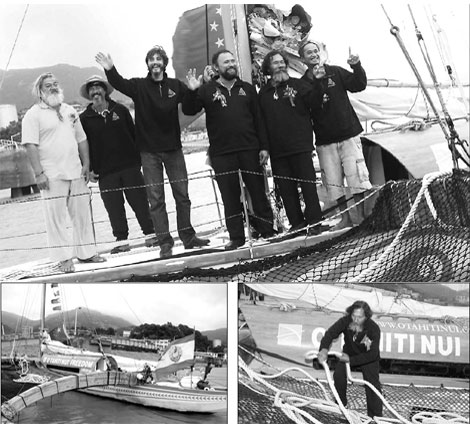Life and Leisure
Ancestral routes
By Zhu Xingxin and Wei Tian (China Daily)
Updated: 2010-12-07 08:06
 |
Large Medium Small |
|
Clockwise from above: Hiria Ottino (third from left) and his five crew members are welcomed at Mawei harbor, Fujian province, after a 16,000-nautical-mile South Pacific voyage of 116 days. Koronui is an experienced sailor known as the "human GPS". Built according to an 1820 plan, Ottino's canoe is 15 meters long by seven meters wide, and weighs four tons. Zhu Xingxin / China Daily |
An ocean voyage to prove that ancient Austronesians originally came from China has been successfully completed by Hiria Ottino. Zhu Xingxin and Wei Tian report
After a South Pacific voyage of 116 days, French Polynesian Hiria Ottino and his five crew members finally berthed their canoe at Mawei harbor, Fujian province, where they believe their ancestors departed on a similar voyage 5,000 years ago.
"When we left French Polynesia four months ago, few people thought we would make it to China. They said our little canoe would capsize in a hurricane," the 42-year-old said on his Nov 19 arrival.
The former adviser to a French Polynesian president says: "We managed to visit 10 countries, travel 16,000 nautical miles (29,632 km) and finally return home."
There are about 270 million Austronesian people scattered on the islands of Oceania and Southeast Asia, such as the Philippines, Indonesia, Micronesia and Polynesia.
Archeological and linguistic evidence seems to show they were originally from coastal areas in Southeast China. Even today, people in Polynesia are familiar with the names "Mawei" and "Pingtan", two cities in Fujian province.
"I have always been curious about what our forefathers went through and how they survived crossing thousands of kilometers across the ocean," says Ottino, who has learnt to speak fluent Chinese over the past two decades.
"For us Polynesians, there is more to learn about our past before we look into the future."
Ottino first came to China in 1987. After years of serving as a diplomat between the two countries, Ottino quit his job in 2009 and decided to find out more about his ancestral roots.
Sailing outrigger canoes built from stone axes, Chinese pioneers are said to have reached as far as Madagascar and Tahiti. Ottino decided to repeat one of these voyages and test whether they were actually feasible given the limited technology of the time.
Built according to a plan drawn up in Tahiti by Admiral Paris around 1820, Ottino's canoe is called Freedom and is 15 meters long by seven meters wide, and weighs four tons. On the mast hang the national flags of the 10 countries they visited, with the Chinese national flag on top.
Ottino did not take any modern devices or products on the voyage - not even instant noodles - in order to make it as authentic as possible. Orientation depended purely on reading the stars and ocean currents, while fishing was the only source of food.
After departing Tahiti on July 27, the canoe followed the winds and currents. On board, however, was Koronui, an experienced sailor in his 60s who Ottino refers to as the "human GPS".
"I just gave him a general direction and he took us there," Ottino says.
"He could tell the depth of water by tasting the salinity, and calculate the distance to land by identifying bird species, because they have different flight ranges."
But even with Koronui on board there were big problems - such as their encounter with typhoon Megi.
"The waves were as high as eight meters and mercilessly crashed into us," Ottino says. "The good thing was that we were not caught out deep in the center of the storm, otherwise even a steel-hulled ship would not have survived it."
Freedom was supposed to reach the Chinese coast on Oct 31, the closing date of the 2010 Shanghai Expo. Because of the delay caused by the typhoon, it arrived 20 days late.
Ottino believes the effort and sacrifice of the journey was worth it.
"I've always felt like there was some connection between the Pacific and China. I hope our journey helps people recognize this connection," Ottino says.
"The world is so complicated and peace is what we are all looking for. If it turns out that we are from one family, peace will be there for us."
But for his long-suffering Chinese wife, Wang Xin, her husband's return is seen in simpler terms. It means she doesn't have to worry about her husband on the high seas any more.
"It means I don't have to worry about storms in the South Pacific thousands of kilometers from home any more," she says.
(China Daily 12/07/2010 page20)
